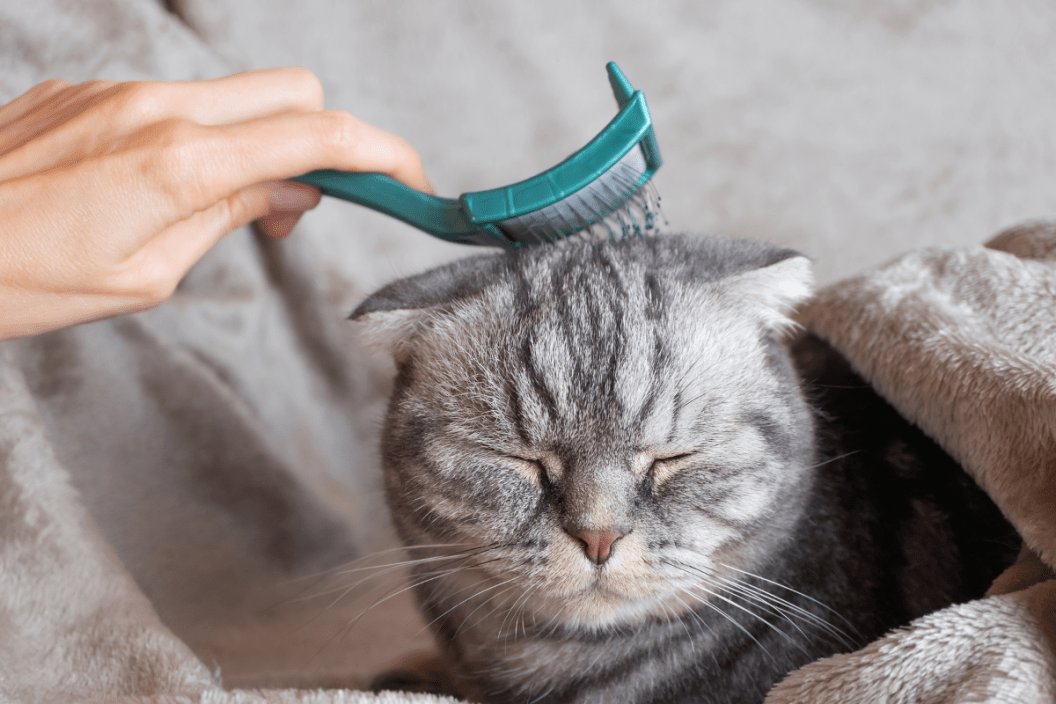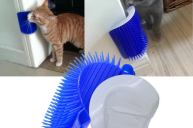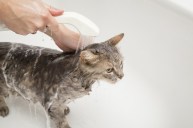Cat grooming can be incredibly difficult, but there are some ways you can make it a bit easier.
Many cat owners would opt to take their furry feline to the groomer instead of attempting an at-home grooming session. However, grooming cats does not have to be a dreaded task. Wide Open Pets spoke to Dr. Christine Sellers, DVM, and veterinary advisor to Cat Person, about how often cats need to be groomed and the best way to go about it, especially if your cat's coat is shedding.
Conditioning Your Cat For Grooming
Even though kittens do not shed, you should prep your cat for the experience. Dr. Sellers told us via email, "Shedding starts at the end of their first year, but acclimating your cat in the first year to being brushed, combed, trimming nails, and home dental care will make all grooming chores going forth a much easier task."
Getting your kitten set up with the appropriate grooming tools from the day you bring them home will help them get used to the task at a young age instead of springing it on them once they are older. Nail trimming also does not start until your cat is over 12 months, but you can still get your cat used to the trimmers you plan on using and get them a scratching post so they can learn to use it instead of your couch.
How To Groom Your Cat Properly
Bathing a cat is far down on the list of cat owners' things to do. Most felines are opposed to even the sight of water if it is not in their water bowl and will balk at the sound of the shower and run away from a spray hose of any kind. However, since cats are known for self-grooming and are said to get offended when you try to bathe them, we asked Dr. Sellers if a bath is a necessity for cats like it is for dogs.
Dr. Sellers said, "As a rule, cats do not need bathing." Most cat owners will cheer to hear that they do not have to risk getting clawed up for the sake of pet care. However, there are some exceptions. Dr. Sellers said that there are about four or so reasons why your cat may need a bath from you instead of from your cat's tongue.
- If they get something sticky or toxic in their fur or are absolutely filthy, you need to remove dirt from your cat's skin and fur.
- If you own a Sphinx, they need to be bathed regularly. This breed is known for having skin problems and needs oils removed every few days.
- Bugs, like fleas, etc. Sellers says, "If it has an external parasite infestation to keep it from overgrooming and ingesting too much hair after killing the parasites."
- An overweight cat may not clean its hindquarters efficiently, so you will need to help them clean.
- Older cats may also need help grooming if they have arthritis or have trouble reaching their backs and bellies.
Shedding is a huge grooming obstacle that cat owners need to tackle. Indoor cats tend to leave hair everywhere they go, from their cat beds to your favorite chair, whether they are long-haired cats or short-haired cats. Likewise, loose hair tends to go everywhere. Luckily we're here with some cat grooming tips. According to Dr. Sellers, cats tend to shed their undercoat twice a year, once in September and once in February. Both of these sheds help them prepare their coats for the changing of the seasons.
Regular brushing will help stem some of the shedding. Sellers says, "Brushing goes over the topcoat but does not remove the undercoat. It also loosens a lot of the hair that results in the cat going back and ingesting this loosened hair while grooming after the brushing. Wiping off loosened hair with a moist paper towel or friction glove after combing will reduce the amount of hair ingested tremendously."
If your cat's fur tends to get tangles or goes outside and often gets burs, Sellers says, "Using a mat comb dipped in cornstarch will loosen the bur from the fur by allowing the teeth to glide through the fur and catch on the bur only. Comb the cat each time it comes back indoors to prevent the burs from becoming embedded in the deeper fur."
Using a mix of a metal comb and a bristle brush should get most of the cat hair loose from the tangle or bur, leaving you with a pretty kitty. Using a rubber brush is particularly effective for removing dead hair from short hair cats too.
Don't forget about ear cleaning too! Make sure your kitty's ears are nice and clean and free of build-up. Vets will check their ears during check-ups, but it does not hurt to make sure there is no gunk or burs inside them. Take a cotton swab or a cotton ball to the outside of the ear and gently wipe away any dirt or grime that may be there.
What To Do About HairBalls?
RELATED: Cat Throwing Up White Foam? Here's How to Help
Some cats are chronic hairball sufferers, even if they are taking furball lubricant. It can get worse during their seasonal shed. As a general part of cat care, make sure your furry feline has a balanced diet with plenty of moisture. Sellers says, "Giving them primarily wet food, one tbs of pumpkin twice a week, a furball lubricant twice a week, and combing with a flea comb or narrow tooth comb is best."
Cutting Cat's Nails
Cutting your cat's claws is only a little less intense than trying to bathe them, but it is essential to grooming cats. If their nails get too long, they can splinter or they can get caught on things and tear. Dr. Sellers said that a cat's nails need to be trimmed every 3-4 months if your cat is older than 12 months. If your cat is constantly digging into your skin, you may need to trim them more often. For nail clipping, she said it is best to use side cutters instead of Guillotine cutters since they are gentler on the nails.
To cut with the nail clippers, Sellers said to take the following steps:
- Hold your cat's foot gently, pushing on the base of the toes to extend their nail
- You will be able to see their vein as a pink line vs. their white nail
- You should cut away from the vein so there is no pain or bleeding
- Do not cut head-on. Rather cut at an angle so their nail won't splinter
Make sure you stay away from that blood vessel. It will be painful for your cat if you cut too close to the vein and it may bleed. If you do knick the vein, you can apply some styptic powder to stop the bleeding.
Brushing Your Cat's Teeth
The thought of brushing your cat's teeth may have you wanting to run to a professional groomer, but you can do it at home. It helps if you start brushing your cat's teeth when they are a kitten. Beginning as an adult may not go very well. Dr. Sellers says, "You can easily ruin your relationship with your cat by attempting regular home dental cleaning."
She recommends beginning when they are young and using some moistened, thin gauze on your finger. You can do it with or without toothpaste or dental solution. Sellers recommends wiping the outside of your cat's teeth at least once a week. She says, "This will gently remove plaque from the teeth and gums."
As they get older, you can graduate to a small toothbrush. Keeping your cat's teeth free of plaque will help to prevent health problems later in life.
Do you do all your cat's grooming? Tell us on our Wide Open Pets Facebook page!




